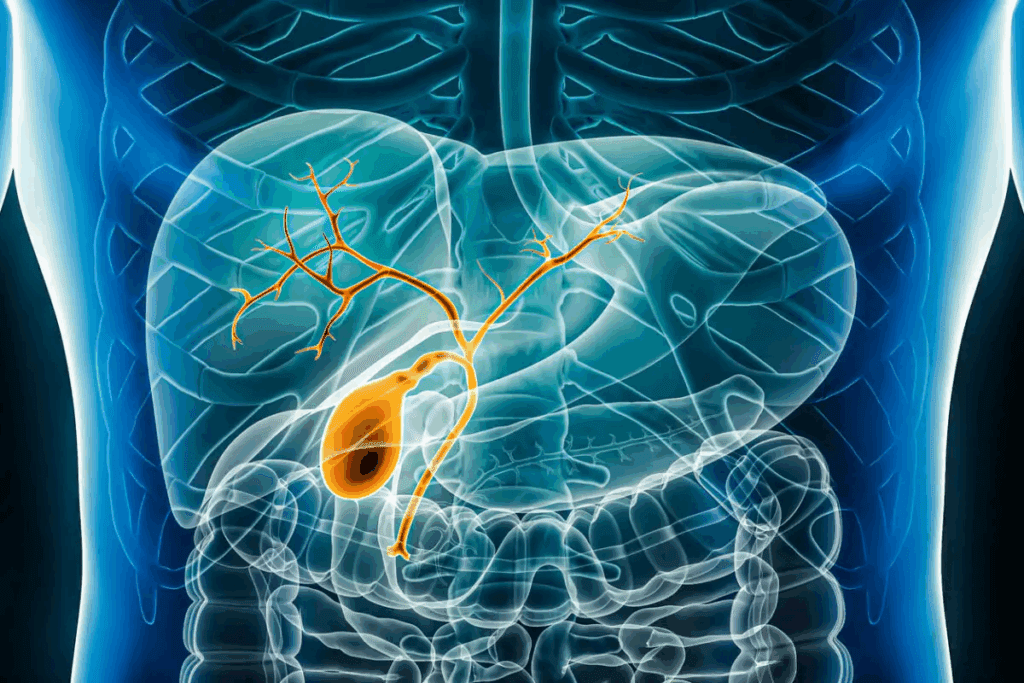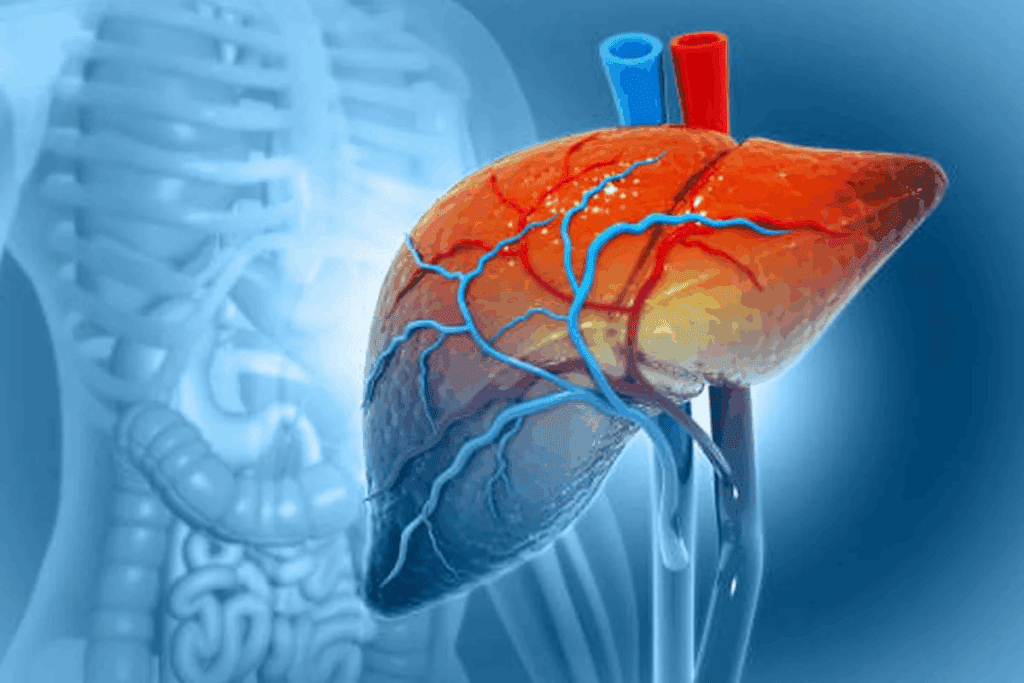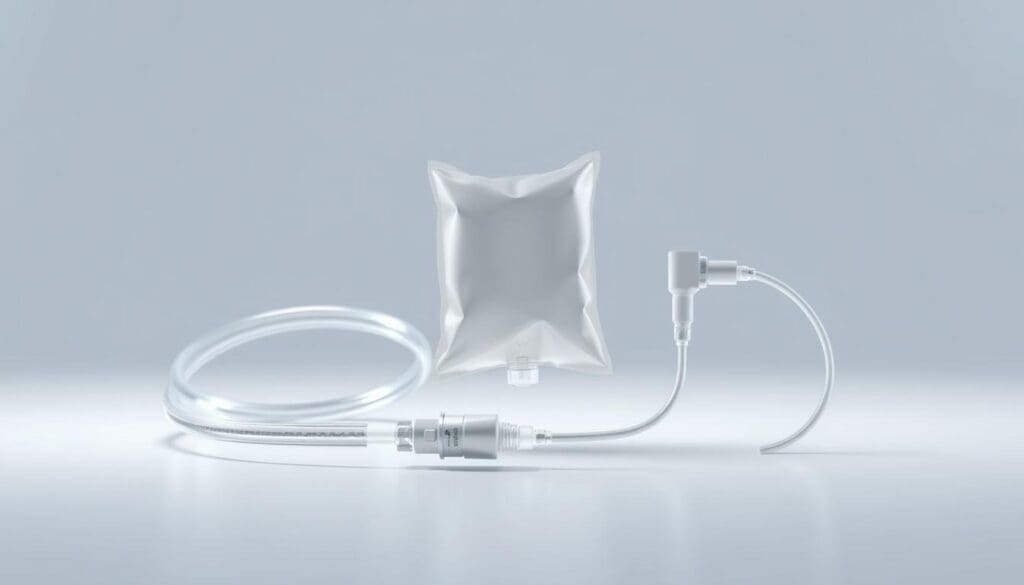Last Updated on November 26, 2025 by Bilal Hasdemir

At Liv Hospital, we know how critical it is to care for biliary drainage tubes and bile drainage bags. A biliary drainage tube is key for removing bile from the biliary tract. It’s vital for managing biliary obstruction and liver issues.
Proper care is essential for patients with a biliary catheter. Learning the right tips for managing these devices can lead to better outcomes. It also brings peace of mind during your treatment.
Key Takeaways
- Understand the importance of proper biliary drainage tube care.
- Learn how to manage your bile drainage bag effectively.
- Discover tips to prevent complications and ensure optimal liver function.
- Find out how to maintain your hepatic drainage system.
- Get expert guidance on caring for your medical devices.
Understanding Biliary Drainage Systems

Biliary drainage systems are key for managing biliary obstructions. They help bile flow normally. Knowing how they work helps patients manage their condition better.
The Role of Biliary Drainage in Managing Obstructions
Biliary duct drainage catheters and bile drainage bags are vital. They manage obstructions in the biliary tract. These can be caused by gallstones, tumors, or inflammatory diseases.
These systems drain bile from the liver or bile ducts. This relieves symptoms like jaundice, itching, and abdominal pain.
Internal-external biliary drainage combines both methods. It’s effective for complex obstructions.
Common Indications for Biliary Drainage
Biliary drainage is needed for several reasons:
- Malignant tumors
- Benign strictures
- Gallstones
- Post-surgical complications
Bile duct catheters and other devices are used to manage these. They help restore bile flow, improving patient outcomes and quality of life.
| Indication | Description | Common Intervention |
| Malignant Tumors | Cancerous growths obstructing bile ducts | Biliary stenting or drainage |
| Benign Strictures | Narrowing of bile ducts due to scar tissue | Dilation and stenting |
| Gallstones | Stones within the gallbladder or bile ducts | ERCP and stone removal |
Bile drainage bags, used with these tubes, collect bile safely. This reduces the risk of skin irritation and infection. Proper care is essential for patient well-being.
Components of a Complete Biliary Drainage Tube System

It’s important for patients to know about the parts of a biliary drainage system. A full system has several key parts that work together. They help ensure bile drains safely and effectively.
Biliary Catheters and Tubes
Biliary catheters and tubes are key parts of the system. These biliary catheters are put into the bile ducts to help with drainage. They come in different sizes and types, based on what the patient needs and the blockage type.
The tubes are made of flexible, durable material. This makes them comfortable and long-lasting. Keeping them clean is important to avoid blockages and infections.
Bile Drainage Bags and Collection Systems
The bile duct bag or liver drainage bag is also vital. These bags collect bile from the liver and bile ducts. They have features to stop leaks and lower infection risk.
It’s important to manage the bile drainage bag well. Patients should know how to empty, clean, and replace it as needed.
Connection Mechanisms and Secure Tubing
Connection mechanisms are key to keeping the system working. They keep the tubing connected to the catheter and bag, stopping leaks and disconnections.
Secure tubing is important to avoid kinks or blockages. This could stop bile flow. The tubing is made to be flexible and strong, with connection mechanisms that are easy and secure.
Knowing about these parts and their roles helps patients manage their systems better. This reduces the chance of problems and improves their life quality.
Types of Biliary Drainage Tube Placement
The type of biliary drainage tube placement depends on the patient’s condition. Biliary drainage tubes help manage bile duct obstructions. The choice of placement varies based on the patient’s situation and the type of obstruction.
External Biliary Drainage Methods
External biliary drainage uses a catheter outside the body to drain bile. It’s used when bile flow needs to be diverted from an obstruction. External biliary drainage is best when internal methods can’t be used due to the obstruction’s location or nature.
Internal Biliary Drainage Procedures
Internal biliary drainage involves placing a stent or catheter inside the bile duct. This method helps restore normal bile flow. It’s beneficial because it allows for natural drainage and can improve the patient’s quality of life by avoiding the need for external drainage bags.
Internal-External Biliary Drainage Benefits
Internal-external biliary drainage combines the best of both worlds. It places a catheter that drains bile both internally into the intestine and externally into a bag. This method is great for patients needing both types of drainage.
Post-Cholecystectomy Drainage Considerations
After a cholecystectomy, post-cholecystectomy drainage is key. The need for a biliary drainage tube can be temporary or long-term. It’s important to monitor and manage these tubes to prevent complications and ensure proper bile drainage.
Tip 1: Proper Daily Flushing Techniques for Biliary Drainage Tubes
To keep biliary drainage tubes working well, daily flushing is key. Patients should stick to a regular flushing schedule. This keeps the tube open and the system working right.
Why Regular Flushing Maintains Tube Patency
Flushing biliary drainage tubes regularly is vital. It removes debris and lowers blockage risks. Daily flushing stops bile salts and other stuff from clogging the tube, keeping it open and working.
Keeping the tube open is super important. A blocked tube can cause serious problems like infections and bile leaks. Daily flushing helps avoid these issues.
Step-by-Step Flushing Protocol
To flush a biliary drainage tube right, follow these steps:
- Get ready with sterile saline solution, a syringe, and any other needed stuff.
- Wash your hands well before touching the tube or flushing gear.
- Take off the drainage bag from the tube, keeping it clean.
- Put the syringe on the tube and gently flush with the right amount of saline.
- Put the drainage bag back on, making sure it’s secure.
It’s vital to stick to the flushing plan your doctor gives you. The amount and how often you flush can change based on your needs.
Recommended Flushing Solutions and Volumes
Choosing the right flushing solution and amount is key. Normal saline is often used because it’s safe for the biliary system.
Flushing volumes usually range from 10 to 20 milliliters. But, it depends on the tube type and your health needs. Always listen to your doctor about the best solution and amount for you.
By following a good daily flushing routine, patients can keep their biliary drainage tubes working well. This reduces the chance of problems and improves life quality.
Tip 2: Maintaining Sterile Dressing Changes to Prevent Infection
To keep biliary drainage tubes working well, it’s key to follow a strict protocol for dressing changes. Keeping everything sterile during these changes is vital. It helps protect the catheter site from infections.
Frequency of Dressing Changes Based on Current Protocols
The timing of dressing changes can change based on the healthcare provider’s rules and the patient’s health. Usually, they are done every 7 to 10 days. Or, they are done when needed, depending on the patient’s health and the dressing type.
Key factors influencing dressing change frequency include:
- The type of dressing material used
- The presence of drainage or moisture under the dressing
- Patient-specific factors such as skin condition and overall health
Sterile Technique for Catheter Site Care
Keeping the catheter site clean and sterile is very important. This helps avoid bacteria and other harmful germs. Here’s how to keep the site clean:
- Gather all needed supplies, like sterile gloves, antiseptic solution, and dressing materials.
- Wash your hands before putting on sterile gloves.
- Clean the catheter site with antiseptic solution, moving in a circular motion outward from the catheter.
- Let the area dry completely before putting on a new sterile dressing.
Recognizing Signs of Infection at Insertion Site
It’s important for patients and caregivers to know the signs of infection at the catheter site. Look out for:
- Redness, swelling, or warmth around the insertion site
- Pus or discharge from the site
- Increased pain or tenderness at the site
- Fever or chills
If you see any of these signs, contact a healthcare provider right away. They can give further advice and help if needed.
Tip 3: Monitoring Biliary Drainage Color and Volume for Complications
Watching the color and amount of biliary drainage is key for those with drainage tubes. It helps understand their health and any problems. We stress the need to watch closely to catch issues early.
Normal Biliary Drainage Color Variations
Biliary drainage colors can range from golden yellow to dark green. The normal color is often described as “bile-colored.” This range comes from bile’s mix of bilirubin and other stuff. We tell patients that changes within this range are usually okay.
Abnormal Colors and What They Indicate
Abnormal biliary drainage colors can mean trouble. For example:
- Pale or clay-colored drainage may mean there’s not enough bile or a blockage.
- Bright red or bloody drainage points to bleeding in the biliary system.
- Dark or black drainage could be old blood or other problems.
We remind patients to tell their healthcare team right away if they notice big changes in color.
Tracking and Recording Drainage Output
Keeping track of how much biliary drainage is just as important as its color. Patients or their caregivers should log the output daily, at the same times. This helps spot trends or sudden changes that might mean trouble. Regular logging helps catch problems like blockages or tube issues early.
“Monitoring drainage output is a critical component of biliary drainage care. It allows for the early detection of possible complications.”
Cholecystectomy Drainage Color Monitoring
For those who’ve had their gallbladder removed, watching the drainage color is even more critical. Abnormal colors after cholecystectomy might mean infection or bile leak. We advise patients to follow their doctor’s advice on what to look for and when to get help.
By keeping a close eye on biliary drainage color and volume, patients and doctors can spot and fix problems early. This helps improve health and lowers the chance of serious issues.
Tip 4: Proper Bile Drainage Bag Management and Skin Protection
Handling bile drainage bags right is key to avoiding skin problems. It’s vital for those with biliary drainage procedures.
Optimal Positioning of Liver Drainage Bags
Putting the liver drainage bag in the right spot is important. It stops leaks and cuts down skin irritation risk. Place it below the biliary tube for better drainage.
Make sure the bag is secure to avoid discomfort or issues. It should not be pulled or twisted.
Emptying and Measuring Hepatic Drainage
It’s important to empty the hepatic drainage bag regularly. Empty it when it’s half full to avoid leaks. This keeps things clean.
Measuring the drainage is also key. It helps doctors see how well the drainage is working. They can then make needed changes.
| Measurement | Frequency | Purpose |
| Drainage Volume | Each Emptying | Monitor Output |
| Drainage Color | Each Emptying | Assess Bile Characteristics |
| Bag Condition | Daily | Check for Leaks or Damage |
Preventing Skin Irritation and Breakdown
To avoid skin problems, clean the area around the catheter with mild soap and water. Use a barrier cream to protect the skin from bile.
Check the skin daily for signs of irritation or breakdown. Catching it early helps prevent bigger issues.
By managing bile drainage bags and protecting the skin, patients can lower the risk of complications from biliary drainage.
Tip 5: Ensuring Patency of the Biliary Drainage Tube System
Keeping the biliary drainage tubes open is key for good liver function. Doctors use a bile duct catheter and an internal-external biliary drain to watch the flow. This helps prevent blockages and ensures the liver drains properly. We’ll talk about keeping the tubes open, spotting blockages, and how to care for the bile duct catheter.
Recognizing Signs of Tube Blockage
It’s important to know when the tube might be blocked. Look out for less or no drainage, pain in the belly, fever, and yellow skin or eyes. If you see these signs, call your doctor right away.
| Signs of Tube Blockage | Possible Causes | Action Required |
| Decrease or stop in drainage output | Blockage, kinking, or displacement of the tube | Check tube positioning and flush according to protocol |
| Abdominal pain | Blockage, infection, or bile duct damage | Contact healthcare provider for assessment |
| Fever | Infection | Notify healthcare provider and consider antibiotic therapy |
| Jaundice | Blockage or inadequate drainage | Check drainage output and tube patency, consult healthcare provider |
Preventing Tube Kinking and Displacement
To keep the tube working right, make sure it’s not kinked or moved out of place. The tube should be securely attached to your skin. Also, check the tube’s position often and adjust it if needed.
Bile Duct Catheter Maintenance Protocols
It’s important to take care of the bile duct catheter to keep it open. This means flushing it with sterile saline solution as your doctor tells you to. How often and how much you flush will depend on your needs and the hospital’s rules.
- Flush the catheter with sterile saline as directed by your healthcare provider.
- Check the catheter site for signs of infection or irritation.
- Ensure the drainage bag is properly positioned and not twisted or kinked.
When to Contact Healthcare Providers
If you notice any problems with your biliary drainage tube, like less drainage, pain, fever, or yellow skin, call your doctor. Also, don’t forget to keep up with your follow-up appointments. This helps keep your biliary drainage system healthy and working well.
By following these tips and staying in touch with your healthcare team, you can keep your biliary drainage tube system working right. This reduces the chance of problems and helps you feel better overall.
Tip 6: Managing Daily Activities with Internal-External Biliary Drainage
Patients with internal-external biliary drainage can stay active with some tips. This system helps the liver work better and aids in recovery. It might be hard to manage daily tasks, but with the right tips, it’s easier.
Bathing and Showering Guidelines
Keeping clean is important, and patients can do so safely with precautions. Cover the drainage site with a waterproof dressing to keep water out. Also, avoid submerging the catheter in water until it’s okay with your healthcare provider.
Precautions during showering:
- Use a waterproof dressing to cover the catheter site
- Avoid direct water pressure on the catheter
- Gently clean around the catheter site
Clothing Considerations and Bile Drain Bag Concealment
Wearing the right clothes can hide the bile drain bag and feel better. Choose loose clothes that fit the bag. There are also vests and bags with pockets for the bag that can help.
Physical Activity Restrictions and Recommendations
It’s okay to do light activities, but avoid hard ones that might hurt the catheter. Talk to your doctor about what activities are safe. Walking is a good exercise for health and recovery.
Travel Considerations with Biliary Drainage Systems
Traveling with this system needs some planning. Carry dressing materials, flushing solutions, and a drainage bag. Tell airline staff or travel authorities about your device. They might have special rules for it.
Tip 7: Troubleshooting Common Biliary Drain Catheter Problems
Biliary drain catheters help manage blockages and ensure the liver drains properly. But, patients often face problems that need quick action. We’ll show you how to fix common issues with these catheters.
Leakage Around the Catheter Site
Leakage around the catheter site is a worry. It might happen if the catheter is the wrong size, moved, or blocked. First, look for any kinks or blockages in the catheter. If the problem doesn’t go away, talk to your doctor for help.
Dislodged or Damaged Bile Duct Drainage Catheters
A dislodged or damaged catheter can stop drainage and cause problems. If you think your catheter is out of place or damaged, don’t try to fix it yourself. Call your doctor right away for advice and possible replacement.
Pain or Discomfort Management
Pain or discomfort from biliary drainage catheters can come from many reasons, like how it’s placed or if it’s blocked. If you’re feeling pain, talk to your doctor. They can check it out and help with pain relief.
Bile Reflux Issues and Prevention
Bile reflux happens when bile flows back into the stomach or esophagus, causing discomfort. To avoid bile reflux, try elevating your bed head, wear loose clothes, and follow your doctor’s diet advice.
| Issue | Possible Cause | Action |
| Leakage Around Catheter | Kink or blockage in catheter, improper sizing | Check for kinks, consult healthcare provider |
| Dislodged/Damaged Catheter | Catheter displacement or damage | Contact healthcare provider immediately |
| Pain/Discomfort | Catheter placement, blockage | Discuss with healthcare provider for pain management |
| Bile Reflux | Backflow of bile | Elevate bed head, avoid tight clothing, follow dietary advice |
Knowing how to handle these common problems helps patients manage their biliary drain catheters better. This keeps them healthy overall.
Conclusion: Optimizing Biliary Drainage Care for Better Outcomes
Proper care of biliary drainage tubes and bags is key to avoiding problems and keeping the liver working well. By following seven important tips, patients can improve their care and get better results.
It’s important to flush tubes daily, change dressings, and watch the color and amount of bile. This helps prevent infections and catches problems early. Taking care of the skin around the drainage bag is also critical to avoid irritation.
Patients can manage their care better by knowing about their drainage system and how to handle daily tasks. We aim to help patients manage their systems well. This way, they can have better outcomes by focusing on good biliary drainage care.
FAQ
What is a biliary drainage tube and how does it work?
A biliary drainage tube helps remove bile from the liver. It’s used to manage blockages and other issues. The tube creates a path for bile to drain out of the body.
How often should I flush my biliary drainage tube?
Experts now say to flush daily to keep the tube working right. How often you flush might depend on your specific needs and doctor’s advice.
What are the signs of infection at the catheter insertion site?
Watch for redness, swelling, pain, or discharge around the tube. If you see these signs, call your doctor right away.
How do I manage my bile drainage bag?
To care for your bile drainage bag, place it right, empty it often, and measure the bile. Also, avoid skin irritation and breakdown.
What should I do if my biliary drainage tube becomes blocked or kinked?
If you think the tube is blocked or kinked, call your doctor fast. They’ll tell you how to fix it or adjust it.
Can I bathe or shower with an internal-external biliary drainage system?
Bathing and showering rules depend on your situation and doctor’s advice. Usually, avoid getting the catheter site wet and keep it clean.
How do I troubleshoot common issues with my biliary drain catheter?
For problems like leakage or pain, call your doctor. They can help figure out and fix the issue.
What is the normal color of biliary drainage?
Normal bile color is greenish-yellow. If it looks different, tell your doctor.
How often should I change the dressing around my catheter site?
Dressing changes depend on your needs and doctor’s orders. Usually, change every few days or as needed to keep it clean.
Can I travel with a biliary drainage system?
Yes, traveling with a biliary drainage system is possible. But, you need to plan well. Talk to your doctor about how to manage it while traveling.
References
- Inoue, T., Nagaoki, Y., & Ogura, T. (2023). Current status of percutaneous transhepatic biliary drainage for malignant biliary obstruction. World Journal of Gastroenterology, 29(8), 1220–1235. https://pmc.ncbi.nlm.nih.gov/articles/PMC9945644






